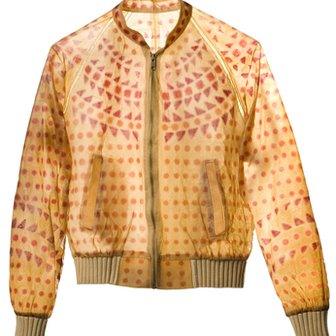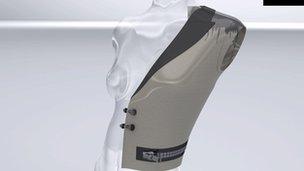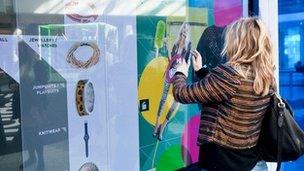Geek chic: When fashion meets technology
- Published
WATCH: Designer Suzanne Lee explains how she grows her own clothes
Like the lycra body suits that were all the rage on the Starship Enterprise, visions of what we will be wearing in the future often verge on the ridiculous.
From wearable music players to LED necklaces to clothes fitted with hidden sensors and wires, it is all a bit wacky, catering for a supposed gap in the market that often doesn't need filling.
For some the future of fashion lies not in design but in smarter fabrics.
And it doesn't get much smarter than the approach of fashion designer Suzanne Lee who is literally growing her own clothes.
Fermenting fabrics

A bio-bomber jacket may represent one future path for fashion
She came up with the idea when researching a book about how fashion would look in 50 years time.
"I had a conversation with a biologist who raised the idea of growing a garment in a laboratory," she told the BBC.
In her workshop in London, she is doing just that.
Using a recipe of green tea, sugar, bacteria and yeast she is able to 'grow' a material which she describes as a kind of "vegetable leather".
The material takes about two weeks to grow and can then be folded around a mould - she has made a dress from a traditional tailor's model but handbags and furniture are also possibilities.
Alternatively it can be dried out and cut and sewn in the traditional manner.
Currently the material is biodegradable and after five years, becomes unwearable, hardening and rotting.
"At that point you can compost it down with all your other vegetable peelings," said Ms Lee.
The fact that the material is cheap to make, cuts out many of the processes associated with making clothes and is eco-friendly, means she has already had interest from several global clothing manufacturers.
"The fashion textile industry is desperately looking to reduce its carbon footprint and look for materials that are more sustainable," she said.
The next stage of the process will be finding a way to preserve the clothes for longer.
"To get it to where it needs to be involves some cutting-edge science but with the right funding in place it has potential to be a radical alternative to traditional textiles," she said.
Fashion engineers

For Julien Fournie geek is the new chic
While computer-aided design and drafting (CADD) is not a new technology, it has rarely been used in the fashion world before but French fashion designer Julien Fournie wants to change that.
Mr Fournie began working in fashion industry under Jean-Paul Gaultier but these days he is more likely to be found hanging out with engineers than with fashionistas.
He has teamed up with engineers at Dassault Systemes, a French software company which more usually creates 3D designs for the car and aerospace industries.
The engineers set about designing software that could turn Mr Fournier's sketches into his next collection.
"At the beginning I was like a laboratory rat, lots of engineers and geeks around me. But they listened to me, they wanted to find solutions for me. They videoed my habits of working, they wanted to know how I create," he said.
Recently Mr Fournie has been experimenting with making clothes from neoprene, a type of rubber.
It is a difficult material to work with and Mr Fournie's seamstresses suggested that the only way to stitch it would be to use glue.

The engineers worked out ways to work with new materials
"To my mind a glued dress wasn't very sexy," he said.
So he handed the problem over to the engineers.
"They found the right pressure for the needle so it didn't break the material," he said.
The software can also work out how certain fabrics will drape, cutting out the need for expensive experimentation with the real thing.
"Before I used to sketch from front, back and side and it was difficult. Now I can sketch straight into 3D. I have a digital library of fabric to test and I can explore new shapes and silhouettes.
I am like a child with a new toy," he said.
FashionLab is also working on a "magic mirror", which could eventually be used in shops or on high streets to allow people to see a virtual image of themselves in different outfits.
"A store may have a magic mirror with a personal avatar that can use your exact body measurements to show you how new clothes would look on you," explained Jerome Bergeret, director of FashionLab.
He admits that the project is in its early stages and may be three to five years before it becomes a reality.

Shoppers could create their own mood boards
Fashion may begin on a designer's drawing board but it ends up on the High Street and here the effects of technology have, to date, been largely negative.
Online retailers are nibbling away at the High Street and with shops shutting down, retailers are looking to technology to help keep customers in stores.
At the Future Fashion event at the Westfield shopping centre in west London, shoppers recently got a glimpse of how stores may embrace technology in the coming years.
Alongside tweet mirrors and Facebook booths, allowing customers to share their purchases on social networks, shoppers were also invited to create their own 'mood boards' using huge touch screens.
"This kind of technology allows us to give ownership back to shoppers, they can curate their own collections," said Myf Ryan, Westfield's head of marketing.
But, while she said shoppers and retailers loved the technology on show, she admits that Westfield is making no long-term commitment to such gadgetry.
Stores are still working out how they will look in the future, she said.
"Technology is irreversibly changing the tradition patterns of shopping."
"The question is how you take the benefits of the digital environment and make a more enjoyable environment for bricks and mortar shoppers"
- Published9 August 2010